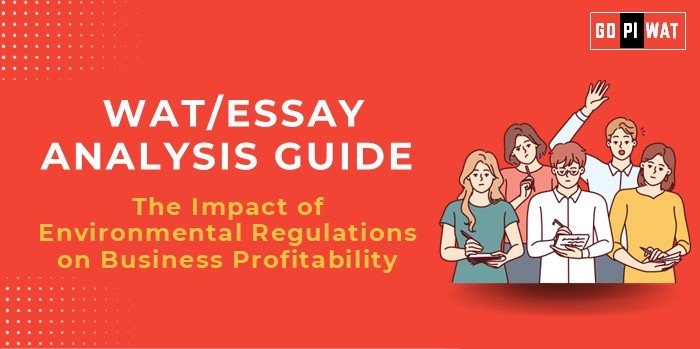📋 Written Ability Test (WAT)/Essay Analysis Guide
Topic: The Impact of Environmental Regulations on Business Profitability
🌟 Understanding the Topic’s Importance
This essay explores the delicate balance between enforcing environmental sustainability and maintaining economic viability—a critical consideration for future business leaders aiming to integrate profitability with environmental responsibility.
⏱️ Effective Planning and Writing
- Time Allocation:
- 📝 Planning: 5 minutes
- ✍️ Writing: 20 minutes
- 🔍 Review: 5 minutes
💡 Introduction Techniques for Essays
- Contrast Approach:
“While stringent environmental regulations can increase compliance costs, they also drive innovation and build consumer trust, highlighting a complex dynamic between sustainability and profitability.”
- Timeline Approach:
“From the establishment of the Kyoto Protocol to the adoption of the Paris Accord, global environmental policies have continually shaped corporate strategies, influencing profitability and sustainability.”
📊 Structuring the Essay Body
🏆 Achievements
- 📈 ESG Investment Growth: ESG investments reached $35.3 trillion, showcasing market commitment to sustainability.
- 🚗 Corporate Innovation: Tesla exemplifies how aligning business models with environmental regulations can drive profitability.
- 🌱 Policy Success: Germany’s renewable energy transition demonstrates the impact of well-implemented regulations.
⚠️ Challenges with Comparative Analysis
- 💰 High Compliance Costs: SMEs face financial strain due to expensive regulatory requirements.
- ⚖️ Uneven Enforcement: Regulatory uncertainties hinder consistent progress across industries.
- 🌍 Global Disparities: Comparisons between Sweden and India reveal gaps in resource availability and enforcement mechanisms.
🚀 Future Outlook
- 🤖 Advanced Technologies: AI and blockchain can streamline compliance monitoring and enhance transparency.
- 📜 Global Learnings: Countries like Sweden and Germany demonstrate the potential of combining strict regulations with economic incentives.
- 🎯 Recommendations: Adopt tax breaks for green innovation and simplify regulatory frameworks to encourage compliance.
📄 Concluding Effectively
- Balanced Perspective:
“Environmental regulations, while presenting short-term financial challenges, are essential for fostering long-term sustainability and innovation. Businesses that embrace these changes are better positioned to thrive in a future where environmental responsibility is paramount.”
- Global Comparison:
“Lessons from countries like Germany and Sweden demonstrate that stringent environmental regulations, when coupled with incentives, can drive both economic growth and sustainability, paving the way for a more balanced global economy.”
📈 Analyzing Successes and Shortcomings
✅ Key Achievements
- 📊 Growth in ESG investments highlights market alignment with sustainability goals.
- 🔬 Technological advancements driven by regulatory mandates promote green innovation.
- 🌎 Renewable energy policies showcase global successes, such as Germany’s Energiewende initiative.
⚠️ Ongoing Challenges
- 💸 High compliance costs pose financial barriers, particularly for SMEs.
- 🔄 Inconsistent enforcement and regulatory ambiguities slow progress.
🌍 Global Context
- 🇸🇪 Sweden’s carbon neutrality policies demonstrate how strict regulations can lead to sustainable success.
- 🇩🇪 Germany’s Energiewende highlights the balance of economic growth with environmental responsibility.
🌟 Recommendations for Sustainable Progress
- 🌐 Global Standardization: Encourage international agreements to establish uniform compliance standards for multinational businesses.
- 💰 Incentives for Green Innovation: Governments should offer tax breaks and grants for businesses investing in sustainable practices.
- 🤖 Technology Adoption: Utilize AI and blockchain for efficient compliance monitoring and data transparency.
✍️ Sample Short Essays
- Balanced Perspective:
“Environmental regulations are often viewed as barriers to profitability, but they also drive innovation and foster consumer trust. For instance, Tesla’s growth demonstrates how aligning business goals with sustainability can yield financial and reputational gains. While compliance costs remain a challenge, the long-term benefits of embracing environmental responsibility far outweigh these initial hurdles.”
- Solution-Oriented:
“Adopting global compliance standards and leveraging advanced technologies like AI can significantly reduce the cost of adhering to environmental regulations. These steps not only ensure sustainability but also provide businesses with a competitive edge, as evidenced by the growing market for eco-friendly products and services.”
- Global Comparison:
“Countries like Germany have shown that stringent environmental regulations can coexist with economic prosperity. By integrating incentives with compliance measures, businesses can achieve a balance between profitability and sustainability, ensuring long-term success in a rapidly evolving global economy.”
📚 Engagement Tips for B-School Applications
- 📘 Linking to B-School Projects: Explore the intersection of business and environmental policy, focusing on ESG metrics and their impact on investment decisions.
- 📊 Using Advanced Data Tools: Analyze real-world case studies like Tesla or the European Union’s Green Deal to understand the profitability implications of environmental policies.
- 💡 Exploring Strategic Recommendations: Propose solutions such as carbon offset programs or renewable energy adoption in class projects or discussions.


